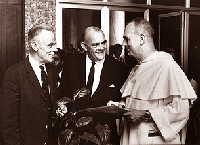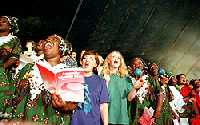In 1937, church leaders agreed to establish a World Council of Churches, but its official organization was deferred by the outbreak of the second world war until August 1948, when representatives of 147 churches assembled in Amsterdam to constitute the WCC.
Since then, a growing number of churches on every continent has joined in this search for Christian unity. They have built new bridges over ancient chasms separating believers from one another.
WCC member churches today include nearly all the world’s Orthodox churches, scores of denominations from such historic traditions of the Protestant Reformation as Anglican, Baptist, Lutheran, Methodist and Reformed, and a broad representation of united and independent churches.
The world’s largest Christian body, the Roman Catholic Church, is not a member of the WCC, but has worked closely with the Council for more than three decades and sends representatives to all major WCC conferences as well as to its Central Committee meetings and the assemblies. The Pontifical Council for Promoting Christian Unity appoints 12 representatives to the WCC’s Faith and Order Commission and cooperates with the WCC to prepare resource materials for local congregations and parishes to use during the annual Week of Prayer for Christian Unity.
The goal of the World Council of Churches is not to build a global "super-church", nor to standardize styles of worship, but rather to deepen the fellowship of Christian churches and communities so they may see in one another authentic expressions of the "one holy, catholic and apostolic church". This becomes the basis for joining in a common confession of the apostolic faith, cooperating in mission and human service endeavours and, where possible, sharing in the sacraments. All these acts of fellowship bear testimony to the foundational declaration of the WCC that the Lord Jesus Christ is "God and Saviour according to the Scriptures".

The 1937 Oxford Life and Work Conference, "Church, Community and State", approved a merger with Faith & Order that would form the World Council of Churches. WCC Photo

The first meeting of the Joint Working Group set up by the WCC and the Roman Catholic Church took place in 1966. Moving from left to right: Dr A.W. Visser't Hooft (NL), Dr Eugene Carson Blake (USA), Father Jérôme Hamer (France). WCC Photo/John Taylor

Worship at the Harare Assembly (1998). WCC Photo/Chris Black
